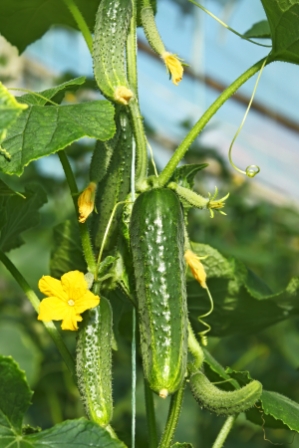Eaten fresh or preserved as pickles, cucumbers are a popular vegetable and an easy one to grow. As long as rain or irrigation is available, it only takes between 55-60 days from planting them to picking them in most areas of the country. If they are grown up a fence, they will only require two square feet of the garden plot, to provide a family more than enough for a season full of this cool, juicy, tropical cultivar.

Types of Cucumbers
Cucumbers range from small pickling cucumbers called gherkin to long thin “yard-long french typed ones used for slicing. When choosing a cultivar, be certain that you get the right type for what you have planned. Get a slicing cucumber for cucumbers that you want to eat fresh and a pickling type for making pickles. If space is a concern you should consider bush type cultivars because they have small compact vines.
Planting
Cucumbers love the nutrients provided in humus so before planting amend the soil with as much compost and well-rotted manure as possible. The soil should be well drained and there should be at least 6 hours of direct sun on the garden bed each day.
It is best to avoid planting them too early. Wait until 3-4 weeks after the last frost to be certain the soil has adequately warmed. I usually have already planted a spring crop of peas along the fence in which I plan to grow the cucumbers Plant them in a one inch deep hole, sprinkle some kelp into the hole and drop in the seeds into the hole. Water them well, cover with an inch of soil and water them again. I plant cucumber seeds about a foot apart along the fence.
Care During the Growing Season
The cucumbers should receive at least one inch of water per week for the entire growing season. If the cucumber plants do not get enough water they will stop growing and dry out. In addition, the cucumbers themselves will become very bitter. I maintain a thick layer of mulch around the cucumber plant and can easily pull up any weeds that still manage to appear. This also helps maintain adequate moisture for the cucumbers.
As the cucumbers begin to grow, aim the runners toward the fence and the cucumbers will train themselves up the fence. Once the cucumbers reach the fence, pull back the mulch and add a second sprinkling of kelp along with a sprinkling of blood meal. Then add a generous helping of additional compost or composted manure and cover that with more mulch.
Naturally Combat Pests and Diseases
The most common pest problem is the cucumber beetle. They chew on plants and spread diseases like bacterial wilt and mosaic. Combat this by inspecting the leaves and flowers daily and removing any beetles that are located. Planting a few radishes near the cucumbers can help lure some of the pests to the radishes and away from the cucumbers. If the infestation is severe, try covering the cucumbers with a floating row cover. But be sure to remove it after flowering begins to allow bees to pollinate them.
Another common cucumber pest is the squash borer. These pests burrow into the main stem of the plant and leave sawdust-like droppings. Use a sharp knife to cut into the area at the base of the affected stem, remove the worm. Then bury the slit into a pile of moist garden soil so that the plant can re-root itself.
Cucumber diseases can be reduced by rotating crops every year by utilizing both sides and the full length of the fence. One year plant cucumbers on one side of the fence and the next year on the other side and further down the fence line. Minimize diseases spreading by never working in garden when it is wet and by keeping the garden properly watered and mulched.
Harvesting
Pick cucumbers frequently so they do not turn yellow. The size of the cucumbers harvested is determined by the variety. If the seeds of even one fruit are allowed to mature, the entire vine will stop producing. By picking regularly, the harvest can be extended for many weeks. To remove the cucumbers from the vine, gently twist or cut the cucumbers and be careful to not damage the vines in the process. Cucumbers can be stored in the refrigerator for 1-2 weeks. For long term storage of excess cucumbers, consider making pickles or relish.
Tip for Bitter Cucumbers
A strange but effective way to get rid of bitterness in cucumbers is to cut either end of the cucumbers, then take the cut off end piece from one end and rub it cut on the opposite end of the cucumber. Next do the same with the other end of the cucumber with the opposite cut end piece. Throw away the end cuts, but the rest of the cucumber will be sweet and not bitter. I don’t know why it works, I only know that it does.
Donna Brown is the author of the gardening book Simply Vegetable Gardening which is available on her website: Cygnetbrow.com. She can be contacted at cygnetbrown@gmail.com.
Related Articles
Growing Healthy, Productive and Profitable Plants through Succession Planting




Comment here